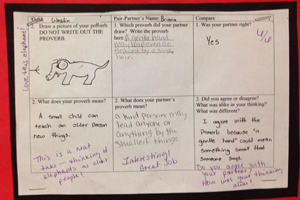INTERPRET PROVERBS—read closely, analyze, create
Interpret a Proverb—Read Thoughtfully
Common Core Anchor Reading Standard 1. Read closely to determine what the text says explicitly and to make logical inferences from it; cite specific textual evidence when writing or speaking to support conclusions drawn from the text.
Choose one proverb or saying. Draw to show what it means.
For example, “Never hesitate to take time to think.”
Draw a ‘literal’ picture--a literal picture could be a picture of a person sitting in a chair.
Draw a ‘context’ picture--show the idea—for example, “Never hesitate to take time to think” could be shown with a picture of a person stopping to make a decision—that could be a picture of a person at a crossroads, stopping to think about which way to go. Robert Frost, an American poet, wrote a poem about that—“The Road not Taken”.
CCSS Anchor Reading Standard 2. Determine central ideas or themes of a text and analyze their development; summarize the key supporting details and ideas.
Group proverbs and sayings based on a theme.
Start with a theme and locate proverbs that relate to it,
or start with a list of proverbs and then sort them into themes.
CREATE
Common Core Anchor Writing Standard 3. Write narratives to develop real or imagined experiences or events using effective technique, well-chosen details, and well-structured event sequences.
Writers communicate ideas in a story.
Write a story or history that would help people understand the message of a proverb.
INSPIRE
Create a calendar of inspiring ideas!
Download this page as a PDF file.
